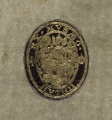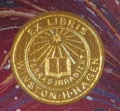Provenance: Difference between revisions
(→List of notable former owners of Folger materials: Added Robert S. Pirie) |
(→List of notable former owners of Folger materials: Added Henry N. Paul) |
||
| Line 40: | Line 40: | ||
* [[Jerome Kern]] | * [[Jerome Kern]] | ||
* [[Thomas Jefferson McKee]] | * [[Thomas Jefferson McKee]] | ||
* [[Henry Neill Paul]] | |||
* [[Robert S. Pirie]] | * [[Robert S. Pirie]] | ||
Revision as of 09:06, 21 January 2016
Provenance is the record of ownership of an object. Provenance can be established through external records, such as sales receipts and booksellers' ledgers, and through internal marks and additions, such as ownership inscriptions and bookplates.
Types of evidence for establishing provenance
External
Many of the Former Owners of Folger items collected more than books. Letters, miscellanies, receipts, ledgers, and library catalogues help trace books as they passed from one person or institution to another. For more information on specific former owners, a good place to start looking is http://findingaids.folger.edu/. For example, Edwin Booth's letters discuss his dealings with booksellers (both buying and selling), his own writing, and books that he has read.
Internal
Signatures
Owner's names appear in many places in early modern books. While title pages and the first leaf of the text are common, names may appear throughout the work, and you can often find signatures on the final leaf or at random locations in the middle of a text.
Bookplates
Bookplates come in many sizes and materials including leather and vellum, but are commonly made of paper and pasted onto the front pastedown or flyleaves of the book. Bookplates often feature heraldic symbolism and family mottos. The Folger's own bookplate, which features Shakespeare's coat of arms, is often tipped to the back pastedown to avoid obscuring earlier provenance information.
The term "Ex Libris," often found on bookplates, translates as "From the library of."
Stamps and embossing
Cataloging policy
The Folger has a long history of providing access to collection materials by former owners' names. The "Former owner" card file can still be found in the card catalog room. Current cataloging policy for vault material calls for noting former owners, evidence of former owners, and the immediate source of acquisition. In addition, former owners (whether people or institutions) can be searched by "Name." For example, the Hamnet record for Folger call number STC 24878.3 includes the notes "Stamp: Julia E. Chafyn-Grove, Zeals House, Bath" and "Purchased from Sokol Books, 2011.05.17," and the name access point "Chafyn-Grove, Julia E., d. 1897, former owner."
While most name access points for former owners say "former owner" at the end, more specific terms are sometimes used. For example, "recipient" after the name of the recipient of a letter implies ownership.



